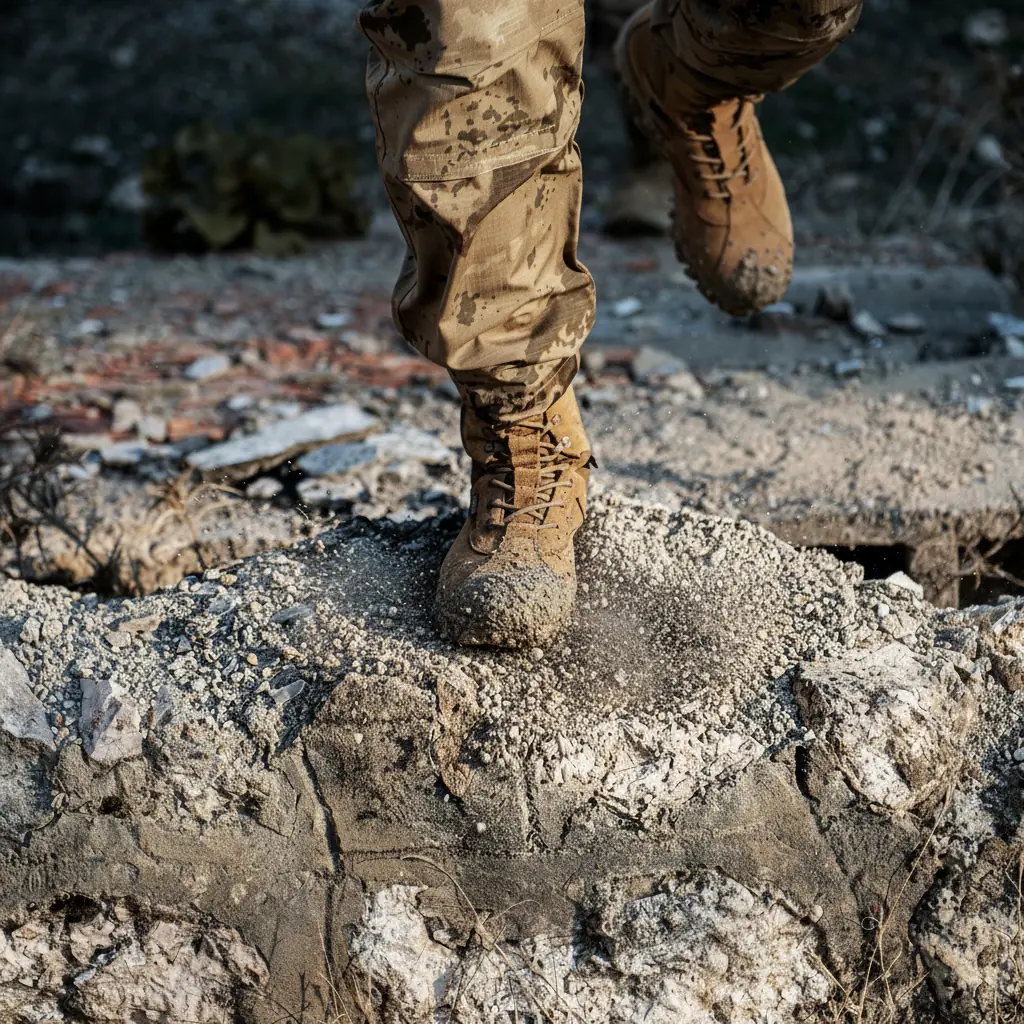How to Clean Military Boots?
November 21, 2025 at 10:39 AMWhy Is Military Boot Cleaning Important?
Military boots are exposed to continuous mechanical stress during long marches, mission transitions and diverse terrain conditions. Mud, dust, sweat and salt residues cling to the surface and reduce the material’s breathability. This increases the risk of drying, stiffening and cracking, especially on sensitive surfaces such as leather and nubuck.
On fabric and Cordura bodies, dirt settles between the fibers, reducing flexibility and weakening the water repellent coating. Small stones and dried mud trapped inside the outsole grooves accelerate the wear of the rubber structure during movement.
From a hygiene perspective, regular cleaning is essential because sweat and moisture create an environment where bacteria proliferate quickly. This leads to odor development and deformation of the inner lining.
Proper cleaning not only maintains appearance but also directly affects the performance and lifespan of military boots in the field.
1. Initial Preparation: Removing Insoles and Laces
Remove the insoles. Insoles retain the most sweat and moisture. Washing them separately improves hygiene and helps the inside of the boot dry faster.
Take off the laces. Removing the laces fully exposes the tongue area, allowing better access during cleaning.
Ventilate the interior. Open the tongue completely to allow airflow. Moisture evaporates and the lining becomes easier to clean.
Brush off loose dirt. Using a medium stiff brush prevents dry dirt from turning into mud during later steps.
Identify the correct cleaning method for the material. Cleaning leather, nubuck, suede or fabric with the same method may cause irreversible damage. Material identification is essential.
This preparation stage ensures the entire cleaning process is more effective.
2. Cleaning Dry Dirt and Mud
Let the boot dry completely. Dried mud separates easily. Wet mud spreads and complicates cleaning.
Use a medium stiff brush. Overly stiff brushes can damage nubuck and suede.
Clean the stitching lines carefully. Dirt trapped in these areas weakens the threads over time.
Remove debris from outsole grooves. Small stones and sand accelerate outsole abrasion.
Shake the boot after brushing. This removes remaining fine dust and prepares the boot for wet cleaning.
After this step, the boot is ready for surface cleaning.
3. Surface Cleaning
Prepare lukewarm water and a neutral cleaner. Harsh chemicals damage boot materials. Neutral cleaners are safer.
Use a microfiber or soft cloth. This prevents scratching on leather or fabric surfaces.
Wipe in circular motions. This loosens dirt and reduces water spotting.
Pay special attention to the tongue. It is one of the areas where sweat accumulates the most.
Remove excess foam with a damp cloth. There is no need to soak the boot. Controlled moisture is best.
After this step, the boot is ready for material specific care.
Cleaning Steps Based on Military Boot Material

Dust and mud accumulated on boots during harsh terrain missions can quickly damage the material structure. Regular cleaning and maintenance is essential for preserving field performance.
Military boots use different materials, each requiring a specific approach. Leather surfaces need oil balance. Nubuck and suede require fiber preservation. Fabric and Cordura surfaces need abrasion control.
Below are the correct cleaning steps for each material type.
Cleaning Leather Military Boots
- Wipe the surface with a slightly damp cloth.
- Do not over wet the leather, as it causes stiffness.
- Use a pH neutral leather cleaner.
- Clean stitching areas with a fine brush.
- Wipe off excess moisture.
- Apply leather conditioner to preserve flexibility and prevent cracking.
- Let the boot dry in shaded, ventilated air.
- Avoid direct sunlight, which accelerates aging.
Cleaning Nubuck or Suede Military Boots
- Start with dry brushing. Never use water as the first step.
- Use a nubuck cleaning eraser for dark marks and shine spots.
- Perform targeted cleaning with a slightly damp suede brush.
- Avoid fully soaking the surface, which causes deformation.
- Apply a nubuck protective spray to strengthen fibers and increase water repellency.
- Let the boot dry naturally, away from heat sources.
Cleaning Cordura / Fabric Tactical Boots
- Brush off dry dust.
- Use lukewarm water and mild detergent to protect the DWR coating.
- Use a soft brush in circular motions to avoid damaging fibers.
- Do not pour water on the boot. Use a damp cloth for rinsing.
- Inspect stitching lines where dirt accumulates most.
- Leave to dry in shade. Heat weakens fabric polymers.
How to Extend the Lifespan of Military Boots
The lifespan of military boots depends not only on material quality but also on consistent maintenance.
- Ventilate the boots after each use.
- Clean or replace insoles regularly.
- Do not expose soaked boots to direct heat.
- Apply leather conditioner to leather boots.
- Brush nubuck and suede regularly.
- Renew the water repellent coating on fabric boots.
- Keep outsole grooves clean.
These steps ensure long term durability.
How to Remove Odor from Military Boots
- Remove and clean the insoles separately.
- Ventilate the interior.
- Apply baking soda.
- Use antibacterial spray.
- Let the boot dry in shade.
- Choose the right socks.
These steps significantly reduce odor formation.
Frequently Asked Questions About Cleaning Military Boots
Can military boots be washed in a washing machine?
No. A washing machine can damage the stitching, outsole and material.
Is it correct to clean nubuck military boots with water?
The surface should not be fully soaked. Dry brushing should be the first step.
Why do military boots crack?
Leather cracks when it loses its natural oils. Regular conditioning prevents this.
How do you polish leather military boots?
Apply a thin coat of leather polish after cleaning and shine with a soft cloth.
Can military insoles be washed?
Yes. They can be hand washed with mild soap and lukewarm water.
How should boot laces be cleaned?
Wash separately with lukewarm water and mild detergent.
